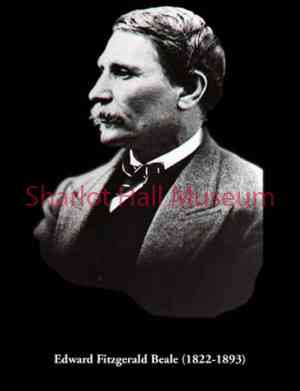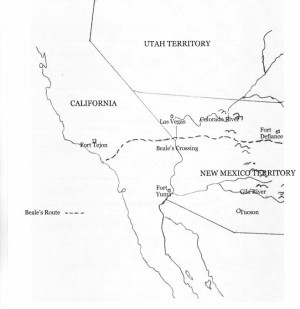By Barbara Patton
On April 22, 1857, Edward Beale, California rancher and former Navy lieutenant, reported to Secretary of War John B. Floyd in Washington D.C. By order of President Buchanan, Beale was appointed to direct a survey and construct a “military road from New Mexico Territory to California.” Thirty-five-year-old Beale was considered an American hero having served bravely with Commodore Stockton and, in 1848, trekking across Mexico to deliver news of California gold strikes to eastern authorities. In 1853, he was appointed Secretary of Indian Affairs in California.
 Although more than capable of leading a road making expedition, Beale may have been surprised that the second part of the mission was for Beale and his group of civilians to test a new weapon of war - camels.
Although more than capable of leading a road making expedition, Beale may have been surprised that the second part of the mission was for Beale and his group of civilians to test a new weapon of war - camels.
The possible use of camels in the American Southwest had been discussed for years. Then, in 1855, Secretary of War Jefferson Davis requested and received funds from Congress to import camels from the Middle East. After two well-planned and executed procurement missions, by 1857, there were over 70 camels housed at Camp Verde, Texas.
In June 1857, Captain Ines Palmer welcomed Beale to Camp Verde, a pleasant fort in the Texas hill country built especially for the Army Camel Corps. Palmer instructed Beale on the nature of camels and their few needs. He confirmed that camels could carry as much as 750 lb. loads over long stretches. He warned that horses and mules could be frightened by the strange beasts, though after realizing the camels wouldn’t hurt them, they generally were fine in their company.
 Beale was introduced to the Arab/Greek camel handlers, Hi Jolly (Hadji Ali) and Greek George (George Caralambo), who had been brought from Turkey to help care for the animals. Palmer also assigned some of his men to accompany Beale’s civilian group which included a few family members, friends, and some former Navy associates.
Beale was introduced to the Arab/Greek camel handlers, Hi Jolly (Hadji Ali) and Greek George (George Caralambo), who had been brought from Turkey to help care for the animals. Palmer also assigned some of his men to accompany Beale’s civilian group which included a few family members, friends, and some former Navy associates.
Beale, with his crew, horses, wagons, mules and 25 camels left Camp Verde on June 19, 1857, heading west. Across west Texas and into the New Mexico territory the camels proved themselves capable of dealing with rainstorms and mud, as well as long stretches of heat with no water. They also accepted local food sources, including mesquite and greasewood, and when they passed households surrounded by cacti fences, the camels helped themselves.
Beale’s admiration for the resourceful animals grew, and he developed a particular fondness for a large, white camel named “Seid.” Some days he rode the camel instead of his horse.
They reached Albuquerque on August 1 and encamped two miles from town. Seeing his group settled, Beale journeyed to Santa Fe to trade with General Garland, exchanging five wagons and 30 mules for a military escort through Indian Country.
Back in Albuquerque, Beale’s men, having been on the march for two months with little diversion, attended a “fandango” in the friendly New Mexico town. While the camels and mules were resting, most of the men headed into town, including Hi Jolly and Greek George. Everybody had a good time until a very drunk Irishman named John Hoyne started trouble, and his friend Joe McFeeley was shot in the hand trying to subdue him.
Unfortunately for the men, that night Beale returned from Santa Fe, and the next day, a contrite group had to account for their actions. John Hoyne and Joe McFeeley were fired. Hi Jolly and Greek George, who at dawn were found in a drunken stupor in a local tavern, returned quietly to camp and tried to look busy and avoid the wrath of their leader.
Next up, Beale’s mission continues across what is today Northern Arizona.
“Days Past” is a collaborative project of the Sharlot Hall Museum and the Prescott Corral of Westerners International (www.prescottcorral.org). This and other Days Past articles are also available at https://sharlothallmuseum.org/articles/days-past-articles.l. The public is encouraged to submit proposed articles and inquiries to dayspast@sharlothallmuseum.org. Please contact SHM Library & Archives reference desk at 928-445-3122 Ext. 2, or via email at archivesrequest@sharlothallmuseum.org for information or assistance with photo requests.


